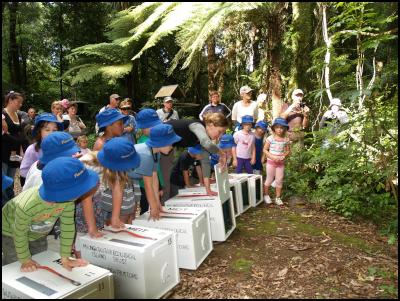Maungatautari Hihi Release Creates a World First
April 15, 2011
Maungatautari Hihi Release Creates a World First
Scientists will be tracking the movements of 39 rare hihi (stitchbirds) for up to three months following their release into the Southern Enclosure at the Maungatautari Ecological Island yesterday.
In what is understood to be a world first, all of the released birds have had micro transmitters attached to their tail feathers that will allow the whole cohort of trans-located birds to be monitored in this way.
The birds have come from Tiritiri Matangi and join more than 200 other hihi previously released or bred on the mountain. The successful past breeding season confirms Maungatautari is the only mainland refuge where the birds are self-sustaining.

Click for big version
The prestigious London Zoological Society, which was involved in the first release of hihi on the mountain, is funding the research associated with this release. It has included carrying out psychological testing on the birds pre-release to establish their individual personality traits.
According to DOC, the stitchbird/hihi (Notiomystis cinch) is one of New Zealand's rarest birds. Recent DNA analysis has shown that hihi are the sole representative of a bird family found only in New Zealand whose closest relatives may be the iconic wattlebirds that include kokako, saddleback and the extinct huia.
In other developments on the mountain Trust staff have reported seven rats have been trapped inside the predator-proof perimeter fence where the surveillance wire has been tampered with by one of four disaffected landowners. It is thought the rats gained entry by climbing up a jumper lead used to short out the surveillance wire.
A request to be allowed to check the fence was refused by the landowner, and it is becoming very difficult to monitor the fence from inside due to rampant weed growth.
While the news that rats have been found inside the perimeter fence is of concern to the Trust, they don’t appear to have spread and are not expected to be a threat to birds breeding inside the Southern Enclosure.
ENDS


 Gordon Campbell: On Surviving Trump’s Trip To La La Land
Gordon Campbell: On Surviving Trump’s Trip To La La Land Transport Accident Investigation Commission: Near-Collision Highlights Safety Lessons For All Busy, Unattended Aerodromes
Transport Accident Investigation Commission: Near-Collision Highlights Safety Lessons For All Busy, Unattended Aerodromes Green Party: Wildlife Law Change A Deep Betrayal Of Public Trust
Green Party: Wildlife Law Change A Deep Betrayal Of Public Trust NZCTU: Unions Launch Petition To Protect Pay Equity
NZCTU: Unions Launch Petition To Protect Pay Equity Greenpeace: Greenpeace Slams PM’s Science Pick - 'Polluters Are Running The Show'
Greenpeace: Greenpeace Slams PM’s Science Pick - 'Polluters Are Running The Show' NZ Government: PM’s Science Prizes Celebrate Excellence
NZ Government: PM’s Science Prizes Celebrate Excellence Department of Conservation: Pinnacles Hut, Summit Track Set For Improvement
Department of Conservation: Pinnacles Hut, Summit Track Set For Improvement 


